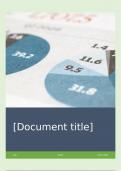[Document title]
User [Date] [Course title]
, Securities Industry Essentials: Tax-
Series 7 Exam – With Questions & All
Accurate Answers (Expert Rated A+)
A customer in the 28% tax bracket has $9,000 of capital losses and $5,000 of capital
gains. How much loss is deductible from this year's tax return? - ANSWER - -$3,000
A customer in the 28% tax bracket has $5,000 of capital losses and $3,000 of capital
gains. How much net capital loss is deductible from this year's tax return? -
ANSWER - -$2,000
-The customer has a capital gain of $3,000 and a capital loss of $5,000, for a net
capital loss of $2,000. The entire net $2,000 loss is deductible since it does not
exceed the maximum $3,000 per year net capital loss deduction.
In the same year, a customer has $14,000 of long-term capital losses on stock
positions and $4,000 of short-term capital gains on options positions. Which
statement is TRUE? - ANSWER - -The capital losses can be netted against the
capital gains and a $10,000 net capital loss is reported, $3,000 of which is deductible
An investor's securities portfolio has depreciated by $6,000 this year. How much of
the loss can the investor deduct on this year's tax return? - ANSWER - -0
-An investor cannot deduct depreciation of an asset that is currently held as a capital
loss. To recognize the loss for tax purposes, he or she must first sell those
securities. Investors can only deduct $3,000 of net realized capital losses per year.
January, 20XX a customer buys 100 shares of ABC stock at $30 per share and pays
a $1 commission per share. The customer receives $1 in cash dividends during the
year. The customer's cost basis in the - ANSWER - -$31 per share
-When the stock is purchased, any commission paid is not deductible - it is part of
the cost basis of the shares. Thus, the cost basis for tax purposes is $30 + $1
commission = $31 per share. The $1 dividend received is included in taxable income
for this year, and is not part of the stock's cost basis.
A corporation declares a cash dividend on Wednesday, December 1st. The record
date is set at Tuesday, December 21st, with the dividend payable on Friday,
December 31st. Based on this information, the ex date is set at Friday, December
17th. The "tax event" occurs on: - ANSWER - -Friday, December 31st
A corporation declares a dividend of $3.00 on Tuesday, December 6th. The record
date is set at Friday, December 30th, with the dividend payable on January 6th.
Based on this information, the ex date is set at December 28th. For the recipient of
the dividend, the "tax event" occurs on: - ANSWER - -January 6th
, -For tax purposes, payments by issuers to securities holders are considered to be
received as of the date the issuer sends the check. In this case, the check is sent on
January 6th (payable date), therefore the income is taxable as of this date.
For tax purposes, cash dividend payments by issuers to securities holders are
taxable as of which date? - ANSWER - -Payable date
Which of the following are taxable in the year of receipt? - ANSWER - -Interest
earned from investments
-Cash dividends from investments
A customer has purchased 1,000 shares of ABC stock at $58 per share, paying a
commission of $2 per share for the transaction. ABC stock declares a 20% stock
dividend. When the dividend is paid, the tax status of the investment is: - ANSWER -
-1,200 shares held at a cost basis of $50 per share
Five years ago, a customer purchased 1,000 shares of ABC stock at $60 per share.
The stock has appreciated in value and is currently worth $100,000. The company
announces that it is spinning off a subsidiary, DEF, to its shareholders. The value of
the new company being spun off equals 10% of the old company. The customer will
have: - ANSWER - -$54,000 cost basis in ABC; $6,000 cost basis in DEF
-The aggregate cost basis does not change in a spin-off. The original investment in
ABC stock had a cost basis of $60,000. The 10% spin off means that 10% of this
value is now attributed to the newly spun-off DEF shares = $6,000. The remaining
value of the ABC shares is $60,000 - $6,000 = $54,000. The current market value
has nothing to do with cost basis.
A customer has purchased shares of stock over an extended period of time at
varying prices. The customer now sells some of the shares. Which statements are
TRUE regarding the tax treatment of the sale? - ANSWER - -The Tax Code allows
specific identification of the shares being sold
-FIFO accounting must be used to establish the cost basis of the shares sold, if no
other tax election is available
Which of the following is reported on Form 1099-DIV? - ANSWER - -Cash dividends
All of the following would be taxed at "earned income" rates under IRS regulations
EXCEPT: - ANSWER - -Interest payments
Under the Internal Revenue Code, royalty income from books, plays, or magazine
articles, is reported as: - ANSWER - -earned income
Which of the following would be defined as "portfolio income" under IRS regulations?
- ANSWER - -Long term capital gains
Royalties received from an oil and gas program are: - ANSWER - -passive income




